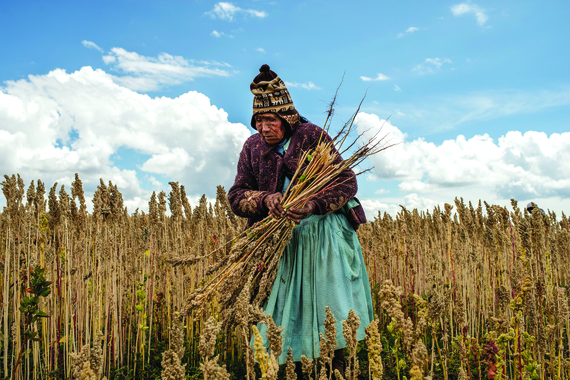Why your quinoa salad is good for rural communities in the Andes, and how to make it even tastier
Worried that your love for quinoa is making the protein-rich grain unaffordable in Latin America? Don't be. A new study shows that rising quinoa prices driven by demand in Europe and the United States improved incomes and food security for poor communities in the crop's native Andean Region. In fact, a fall in quinoa prices since 2014 has hurt livelihoods and nutrition in rural households in Peru's altiplano (literally, 'high plain').
Let's look at the boom times first.
In the ten years leading up to 2013, quinoa prices nearly tripled, on the back of skyrocketing international demand for the latest 'superfood'. The grain had traditionally been cultivated in the high Andean plateau, principally for household consumption. But as prices rose, farmers' incentive to sell it as a cash crop grew.
A debate ensued in the Western media over whether quinoa exports were good or bad for the communities that grew it. One camp argued the staple was becoming unaffordable for poor people in Bolivia and Peru; the other insisted higher quinoa prices were 'the greatest thing that has happened' to Andean smallholders, a large proportion of whom are women.
What neither side in this debate had was data. The new study, Trade in Quinoa: Impact on the Welfare of Peruvian Communities, published by the International Trade Centre (ITC), supplies it.
Higher prices = higher incomes for producers
One track of analysis in the study is based on household consumption data from the Peruvian national statistical office; a household's consumption of goods and services being a reasonable proxy for its well-being.
Researchers Marc Bellemare, Johanna Fajardo-Gonzalez, and Seth Gitter divided households into three groups: quinoa producers; consumers (who eat but don't grow quinoa); and those who neither grow nor eat the grain. Quinoa producers were by far the poorest of the three groups.
After controlling for inflation, they found that between 2004 and 2013, quinoa-producing households saw their overall consumption rise by 46%, more than the increases registered by consumers (31%) and non-consuming households (28%). The welfare gains for quinoa producers grew fastest in 2012 and 2013, at the very height of the price boom.
During the decade-long run-up in prices, the share of Peruvian households consuming quinoa remained constant. And while total quinoa consumption did gently decline, the fact that the trend was unaffected by the spike in 2012-13 suggests this had more to do with changing tastes than affordability.
In quinoa-consuming regions of Peru, a 10% increase in the price of quinoa was found to translate into a 0.7% increase in average household consumption. This might seem counter-intuitive, but the researchers explain that higher incomes for quinoa-producing households likely rippled out across the broader economy. To keep things in perspective: since 2008, quinoa has accounted for only $1 out of every $200 spent by the average quinoa-purchasing household.
New supply bringing prices down
But as is so often the case for agricultural commodities, the quinoa boom contained - quite literally - the seeds of its own decline. High prices encouraged new production, less in the traditional mountain regions of Cusco and Puno than in coastal Arequipa. Lowland yields are many times higher, possibly because of irrigation and pesticide use. The new supply caused prices to fall so much that by late 2015, they were back to 2010 levels.
This is where the study's second track of research comes in. To get more data about how quinoa price changes were affecting livelihoods in the altiplano, ITC, together with the University of Minnesota and Towson University, surveyed 150 households in Puno and Cusco every three months from September 2014 to August 2015, with questions about agricultural production, consumption, nutrition, and so forth.
A clear trend emerged: as global prices fell 40% throughout the year, total food consumption in surveyed households fell by 10%, and wages fell by 5%. Local quinoa consumption fell, as did quinoa sales and purchases. Consumption of potatoes, which contain less protein, filled the gap. Even after the harvest, consumption remained low, suggesting that farmers were storing quinoa in the hope that prices would go back up. Unfortunately, the sacks in which farmers typically store quinoa are vulnerable to rodents and other pests.
What the altiplano needs to compete
The survey found that farmers would be willing to pay for more effective metal silos, albeit less than their cost of production. This suggests that well-targeted subsidies could incentivize the uptake of metal silos by quinoa cooperatives.
But better storage can't solve the supply challenge more productive lowland farms. In theory, the pesticide-free, organic quinoa produced by altiplano farmers could command price premiums among consumers who prize such considerations. This is only possible, however, if their cooperatives have the business skills and market savvy to differentiate their product in export markets. The name of the game is to trade in higher value added quinoa.
In addition, while industrial-scale coastal farms tend to be dominated by a single variety of quinoa, altiplano farmers have traditionally grown many different quinoa varieties. The survey showed that farmers would be willing to plant additional varieties of quinoa in return for payments as low as $10. Such 'payments for ecosystem services' could protect biodiversity in the Andes while providing an additional selling point with environmentally sensitive consumers.
To sum it up, international consumers can rest assured that their quinoa purchases have benefited some of Latin America's poorest people, together with their families. But with support to build storage, create markets for ecosystem services, and help altiplano producers target lucrative higher value-added niche markets, that salad could taste even better.
Follow Arancha González on Twitter: @aranchaglezlaya

